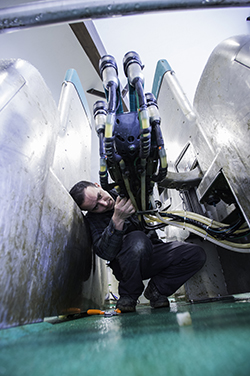Learn as you go
The first year with a robotic system comes with the biggest learning curve in terms of understanding the system and knowing what to look for when performing maintenance.
When your service technician is there to work on the robot, always involve yourself. Be there to greet them when they arrive at the farm, show them what you are seeing, and don’t hesitate to ask questions. You can learn how to identify the most common equipment hurdles and how to work through them.
It’s also helpful to educate your team on how the robot interfaces with cows and data. Understanding how the cows come into the stall and how the ID system, data transfer, and milk handling works will give you better insight into what part of the equipment might not be functioning properly when an issue arises.
Performing regular maintenance, at planned intervals, will also help build the confidence you and your team need to troubleshoot and make some repairs in emergency situations.
Start with what you know
At first glance, troubleshooting issues with a robotic milking system may seem complicated. In reality, most of your maintenance needs will be similar to conventional milking.
When facing a robotic milking issue, start troubleshooting steps the same way you would with a conventional milking system, but review the alarm list to help direct you where to go. Look over your milking stall and make sure liners are seated properly in the shells, hoses are connected properly, and cluster movements are functioning normally. Evaluate your hoses to see if you have a torn milk tube or pulsation hose.
Once you understand the different systems and issues you could run into with a robotic system, troubleshooting will become as second nature as a conventional milking system.
It takes a team effort
Like any milking system, it takes a strong team to ensure your robots perform their best and equipment performance issues are taken care of quickly with minimal downtime.
Start by building a good relationship with your dealer service team. Proactive communication around your farm goals and when and how to bring in your technician will make service calls go smooth, especially in an emergency.
And you don’t want to rely on only one service technician to understand your system. Communicate with your dealer about creating a service team and ensure your on-farm team (employees, maintenance team, farm manager, etc.) understands the system and is updated on protocols.
It will take time, but through a better understanding of your robotic system, building a strong relationship with your dealer service team and being consistent with proactive maintenance, you will be successful in troubleshooting and servicing your robotic milking system.
GEA offers today’s progressive dairy producers leading-edge milking and manure equipment technology, along with a full line of aftermarket products and services – all under one umbrella. With GEA, you truly have a team who offers comprehensive solutions for your operation at the highest possible operating efficiency.




